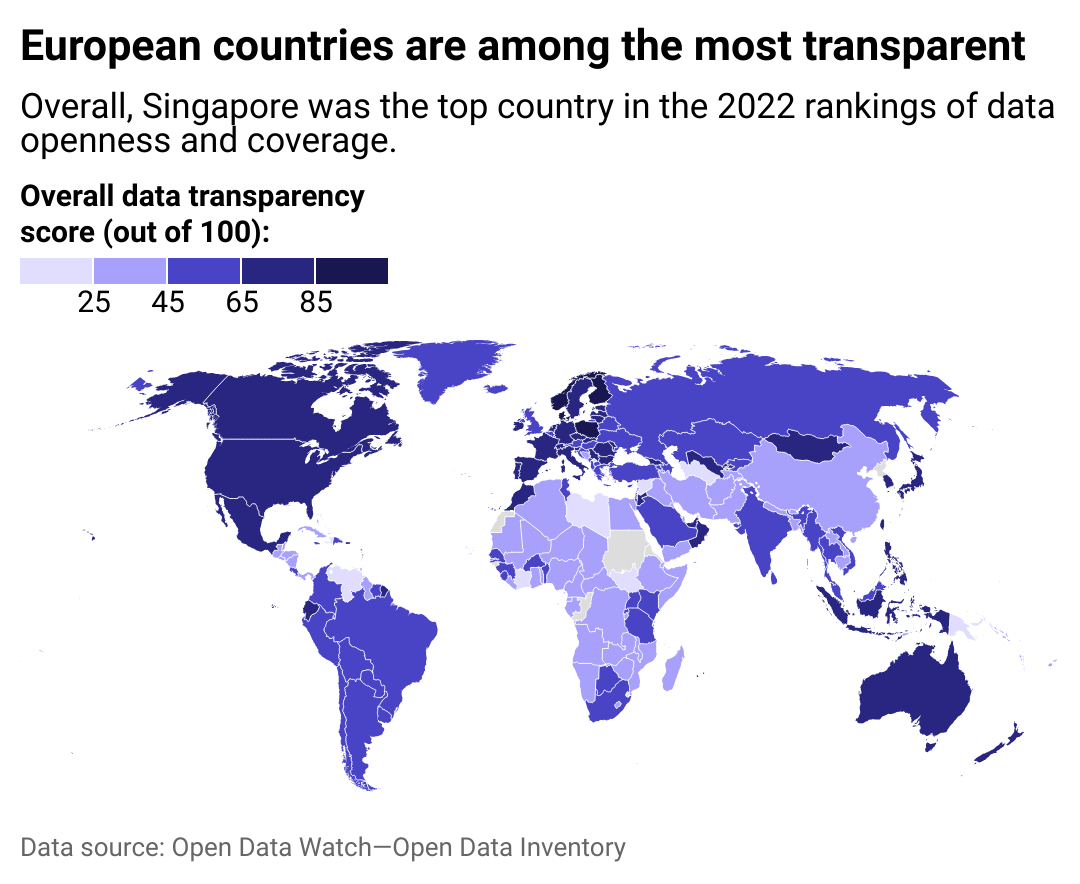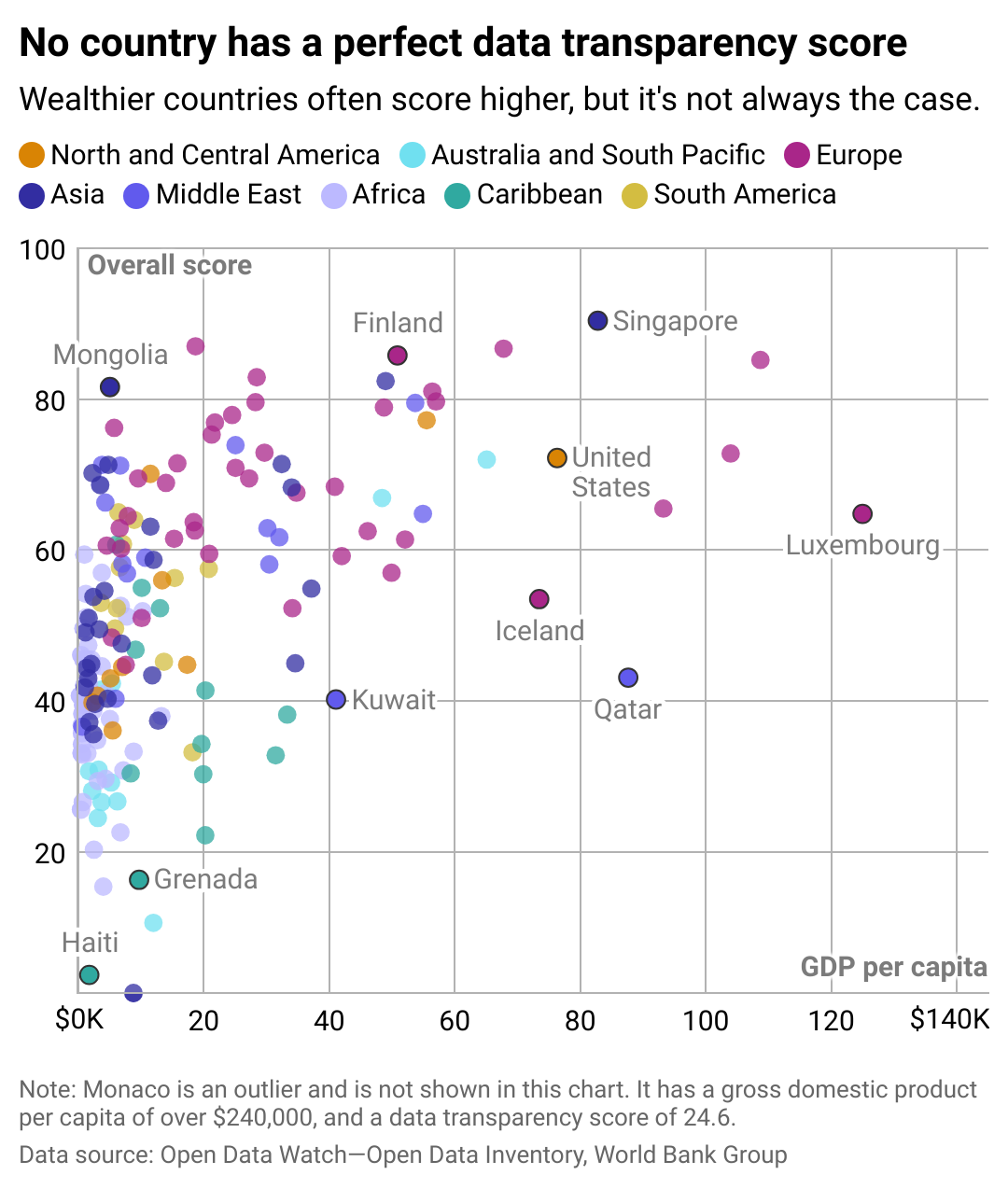How the US ranks globally in data transparency and openness
Photo Illustration by Elizabeth Ciano // Stacker // Shutterstock
How the US ranks globally in data transparency and openness
Collage illustration with magnifying glass over US map and world map.
From the Bureau of Labor Statistics to the Centers for Disease Control and Prevention, the United States has numerous statistical agencies that make federal data available to the general public. However, these systems are not foolproof, and the quality of data collection and dissemination is only as trustworthy as the people at the helm.
The high stakes of a lack of data transparency became apparent during the COVID-19 pandemic—and missteps still reverberate today.
Data transparency has been on a gradual decline in the U.S. since it peaked in 2016, according to the Open Data Inventory index. Today, the nation ranks #22 with a score of 72. In 2016, the U.S. ranked ninth with a score of 76; that’s an improvement after dropping sharply to 70 in 2020 after ranking ninth in 2016 with a score of 76.
The ODIN ranks 195 countries based on data transparency in two categories: openness, or the accessibility of data, and coverage, or the completeness of the data. Each category is scored in points up to 100. As of 2024, the U.S. scored a 64 in coverage and a 79 in completeness.
The U.S. declined in the coverage category following deviations from data collection best practices during the Trump administration’s response to the COVID-19 pandemic. The administration ordered hospitals to forgo reporting to the CDC, the authority for health decision-makers, on threat of loss of funding. Instead, data was sent to a Washington-based database, prompting concerns about transparency, accuracy, and quality. Studies show that inconsistent interpretations of the data, and lack of consensus in terminology between agencies, further impeded policymakers from making evidence-based public health decisions.
The importance of data transparency cannot be overstated. It improves public trust in government institutions by holding them accountable, and quality and timely data collection can have a direct impact on major events like a public health crisis, particularly when data can inform targeted interventions that prevent unnecessary deaths. Accurate data can also empower citizens to make their own evidence-based health decisions.
Although the median coverage score of all countries continues to improve, coverage overall is gradually declining. In the U.S., for example, between 2018 and 2020, the country’s openness score dropped four points while the coverage score dropped three points. Data was not collected in 2019.
The Data Project used rankings from Open Data Watch, a nonprofit that advocates for statistical data collection, to explore how the U.S. compares to other countries in data transparency and openness. Open Data Watch provides policy advice, support, and monitoring for countries’ data collection systems and public openness.
![]()

The Data Project
A look worldwide
World map showing overall scores in data transparency and openness.
Many countries with considerable global influence ranked midway down the list compared to other countries. Russia scored 62 and ranked #57, while India was #82 with a score of 54, tied with much smaller countries like Iceland.
This trend held true for China as well, which achieved a score of 37.4, on par with smaller countries like Namibia and Yemen. This puts the superpower at the bottom of the list at #149.
Luxembourg, the country with the highest gross domestic product, ranked #45 in data transparency with a score of 65, tying with Ecuador, Israel, and Belarus. Singapore, the fourth-leading country by GDP, leads the world in data transparency with a score of 90. It received an openness score of 100, the only country to achieve a score of 100 in any category.
With the exception of Iceland, the Nordic countries all ranked in the top 10 for openness, which measures the completeness of statistical offerings: Denmark ranked third with a score of 87; Finland ranked fourth with a score of 86; Norway ranked fifth with a score of 85; and Sweden ranked ninth with a score of 81.

The Data Project
Lower-income countries fall behind in data transparency
Scatterplot showing no country has a perfect data transparency score. Wealthier countries often score higher, but it’s not always the case. Monaco is an outlier and is not shown in this chart. It has a GDP per capita of over $240,000, and a data transparency score of 24.6.
A country’s relative wealth, as measured by gross national income per capita, generally correlates with greater data transparency. However, while a country’s wealth determines its ability to fund statistical systems, not all countries choose to do so. Many low-income countries exceed comparably richer countries in data transparency, such as Rwanda, with an ODIN score of 59.4 and GNI of $930, compared to Iceland, which has an ODIN score of 53.5 and a GNI of $68,220.
Data accessibility is contingent upon data literacy, freedom of the press, and robust statistical institutions. Even a country with a high ODIN score might not necessarily be transparent. The ability of the country’s journalists to disseminate and investigate information and for nonprofit groups to hold institutions accountable to data accuracy factor into public accessibility and awareness.
For example, while the Russian Federation has an ODIN score of 62, ranking in the upper third of all countries measured in the report, the climate for the country’s journalists has measurably degraded. The country ranks #162 out of 180 countries in the 2023 World Press Freedom Index, which measures the state of press freedom, considering the surge in fake content, propaganda, and artificial intelligence.
Additionally, not all types of data are equally available. Social statistics have remained the least accessible overall compared to economic, financial, and environmental statistics since 2018. Social statistics, which comprises reproductive health care and health outcomes, have a major impact on public health. For instance, without data transparency into the incidence of disease, a timely response that includes contact tracing or distributing resources like medical supplies and vaccines is impossible.
Analyzing trends in data collection also helps identify high-risk populations and monitor the effectiveness of strategies over time. For example, surveillance systems have been successfully used to collect data and identify populations at risk for hemophilia. Data collection in the ongoing HIV epidemic has revealed that infection rates are greater among higher-risk populations in areas where they face more discrimination or are underserved by health care systems.
Though the U.S. has declined in data transparency in recent years, this downward trend won’t necessarily continue. Ongoing and upcoming legislative efforts aim to enhance data transparency, such as the Lower Costs, More Transparency Act, which would provide open and accurate information about hospital pricing, allowing consumers to make more informed decisions. The bipartisan bill passed the House in late 2023 and is awaiting action in the Senate.
Story editing by Alizah Salario. Copy editing by Paris Close.
This story originally appeared on The Data Project and was produced and distributed in partnership with Stacker Studio.
